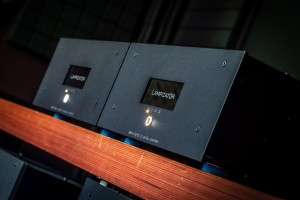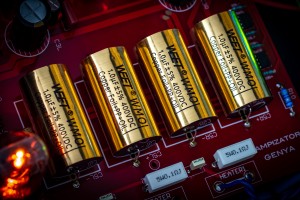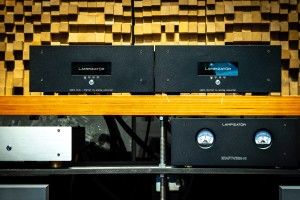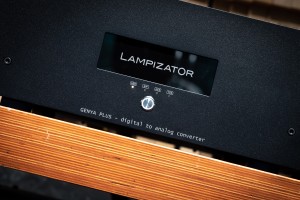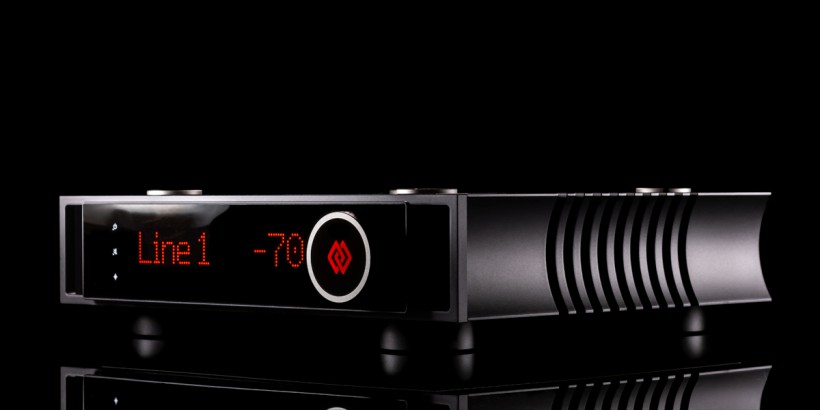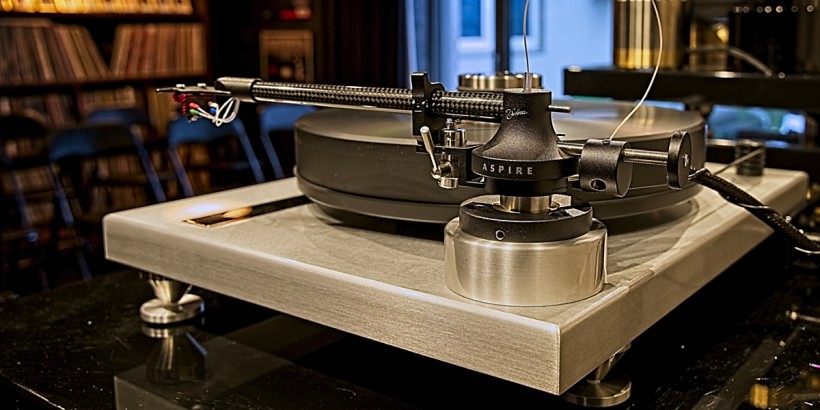LampizatOr Horizon DAC marked a significant, albeit fairly short-lived milestone in the local company’s history. It was replaced by the Horizon360 platform, but the digital engine used in it was too precious to discard. A very special DAC named LampizatOr Genya was built around this circuit. That’s our subject this time around. Enjoy!
Żenia
While this is not a strict rule, audio manufacturers usually keep their flagship designs around for some three to five years, which is a reasonable time frame for them to mint a higher-tiered product and not upset customers by releasing it too soon. The LampizatOr founder Łukasz Fikus followed this protocol for many years with one exception. His 1st-gen Horizon DAC originated as a side project during the COVID-19 era. From one iteration to another, it eventually outperformed the company’s previous best aka Pacific by a significant margin and effectively took the top spot in the lineup. Infused with a brand new H99 digital circuit combined with pentode not DHT output stage, Horizon was unlike anything else Łukasz and his team had done before. An undisclosed D/A chip with some interesting capabilities played the enabler and the LampizatOr CEO was its extremely pleased early adopter. Then this critical part was unexpectedly discontinued and Horizon’s lifespan ended after just over a year.  The resulting void naturally had to be filled, so team LampizatOr got back to the drawing board. The effect of these efforts – Horizon360 – packs a redesigned PSU stage and digital engine that now incorporates a two-part alternative to the previous D/A chip. The local audio house is known for their generous upgrade policy, so 1st-gen Horizon owners could elevate their machines to the 360 status at 15% of their MSRP. Audience for hardware this costly pursues the very best, so over the course of a few months Łukasz and his staff have received several dozen Horizons for the rework. The key step of the procedure narrowed down to replacing the original’s entire H99 digital stage with the new counterpart. The salvaged previous-gen boards that piled up were perfectly fine and excellent on their own right. Considering all the time, money and effort that went into them, throwing that stock away wasn’t an option, so Łukasz built around it a brand new DAC baptized Genya.
The resulting void naturally had to be filled, so team LampizatOr got back to the drawing board. The effect of these efforts – Horizon360 – packs a redesigned PSU stage and digital engine that now incorporates a two-part alternative to the previous D/A chip. The local audio house is known for their generous upgrade policy, so 1st-gen Horizon owners could elevate their machines to the 360 status at 15% of their MSRP. Audience for hardware this costly pursues the very best, so over the course of a few months Łukasz and his staff have received several dozen Horizons for the rework. The key step of the procedure narrowed down to replacing the original’s entire H99 digital stage with the new counterpart. The salvaged previous-gen boards that piled up were perfectly fine and excellent on their own right. Considering all the time, money and effort that went into them, throwing that stock away wasn’t an option, so Łukasz built around it a brand new DAC baptized Genya. From the manufacturer’s site we learn that, during his visit to Ukraine’s city of Lviv in 1995, Łukasz met a local tube guru Evgennyi Kreminski who passed away in 2013 due to cancer. He specialized in push-pull designs based on 6C33C “devil” triodes and authored hundreds of schematics for them over the years. Łukasz saw in Evgennyi a dear friend and mentor who taught him everything he knew about tubes. Today’s Genya DAC was made to commemorate the Ukrainian sifu and his last tube stage that hasn’t yet been used in any previous LampizatOr design. The number of H99 boards extracted from 1st-gen Horizons including servicing spares effectively limits this affair to 40 units. Should you wonder about its name, it is the diminutive of Evgennyi.
From the manufacturer’s site we learn that, during his visit to Ukraine’s city of Lviv in 1995, Łukasz met a local tube guru Evgennyi Kreminski who passed away in 2013 due to cancer. He specialized in push-pull designs based on 6C33C “devil” triodes and authored hundreds of schematics for them over the years. Łukasz saw in Evgennyi a dear friend and mentor who taught him everything he knew about tubes. Today’s Genya DAC was made to commemorate the Ukrainian sifu and his last tube stage that hasn’t yet been used in any previous LampizatOr design. The number of H99 boards extracted from 1st-gen Horizons including servicing spares effectively limits this affair to 40 units. Should you wonder about its name, it is the diminutive of Evgennyi. The digital engine inside LampizatOr Genya primes it as the manufacturer’s affordable take on the Horizon sound. Łukasz explained that this was the top priority indeed, but some compromises had to be made to achieve this goal. First and foremost, Genya is a purist single-purpose DAC without volume regulation, display, Nixies, remote control and tubes exposed on the bonnet. It measures 44 x 55 x 17cm and shows 25kg on the scale. As such it needs similar rack space as Pacific or Horizon yet is easier to lift and move around. On external appeal it scores as high as a big black visually plain box realistically can. That’s by design. It’s no secrecy that the enclosure often eats up the majority of the total manufacturing budget. Genya’s yeoman dress code built upon powder-coated steel plates allowed its makers to funnel most resources into the innards that make the largest difference. I can tell you as early as now that this priority order netted awesome results, but more about that later. When the device is powered on, the window on its front panel shows the manufacturer logo and the currently selected digital input. The pushbutton just a bit below doubles as the secondary on/off and input selector. Genya runs very cool upon touch, so multiple hexagonal perforations on its cheeks and hood are there mainly to elevate aesthetics. The business end is busy with a grounding post, fused IEC inlet with the primary on/off rocker, one of each RCA and XLR outputs (3/6V respectively) and four digital inputs in total; coax S/PDIF, USB, AES/EBU and Toslink. The underside on aluminium pucks with rubber washers seals the deal.
The digital engine inside LampizatOr Genya primes it as the manufacturer’s affordable take on the Horizon sound. Łukasz explained that this was the top priority indeed, but some compromises had to be made to achieve this goal. First and foremost, Genya is a purist single-purpose DAC without volume regulation, display, Nixies, remote control and tubes exposed on the bonnet. It measures 44 x 55 x 17cm and shows 25kg on the scale. As such it needs similar rack space as Pacific or Horizon yet is easier to lift and move around. On external appeal it scores as high as a big black visually plain box realistically can. That’s by design. It’s no secrecy that the enclosure often eats up the majority of the total manufacturing budget. Genya’s yeoman dress code built upon powder-coated steel plates allowed its makers to funnel most resources into the innards that make the largest difference. I can tell you as early as now that this priority order netted awesome results, but more about that later. When the device is powered on, the window on its front panel shows the manufacturer logo and the currently selected digital input. The pushbutton just a bit below doubles as the secondary on/off and input selector. Genya runs very cool upon touch, so multiple hexagonal perforations on its cheeks and hood are there mainly to elevate aesthetics. The business end is busy with a grounding post, fused IEC inlet with the primary on/off rocker, one of each RCA and XLR outputs (3/6V respectively) and four digital inputs in total; coax S/PDIF, USB, AES/EBU and Toslink. The underside on aluminium pucks with rubber washers seals the deal. Taking a peek under my Horizon360’s bonnet took a while, on the contrary to doing the same with Genya. Just undo several bolts that hold its top cover in place, pop it off and presto. JL Sounds asynchronous USB receiver with the H99 module below it make the full digital stage, powered by a dedicated large toroidal transformer by the local company Toroidy.pl. The smaller trafo by the same outlet feeds only tubes. The CLC-filtered EI choke made by Leszek Ogonowski provides the anode voltage for the 6X5 full-wave tube rectifier, selected due to its indirect MO, modest heating needs (0.6A) and low-noise operation. The H99 engine outputs balanced signal to the analog stage built upon a quad of SRPP (Series Regulated Push-Pull) mono amps with one 6N6P dual-triode input buffer in each. In this topology one such tube acts as a common-cathode amplifier, while the other is a cathode follower connected in series. High voltage gain and low output Ω are the useful benefits. Evgennyi used SRPP circuits wherever he could and today’s DAC is the only LampizatOr that incorporates it. Lastly, beefy output signal caps used in Genya are niche copper-foil polypropylene types. The Genya „Lite” version as revewed sells for €16’000 and later on this year we’ll also see its two other siblings. The fancier Genya Plus priced at €19’000 will feature cherry-picked ECC182 tubes and gold-plated PCB, while the €12’000 Genya R2R will rock a digital stage with vintage AD1862 D/A converter in it.
Taking a peek under my Horizon360’s bonnet took a while, on the contrary to doing the same with Genya. Just undo several bolts that hold its top cover in place, pop it off and presto. JL Sounds asynchronous USB receiver with the H99 module below it make the full digital stage, powered by a dedicated large toroidal transformer by the local company Toroidy.pl. The smaller trafo by the same outlet feeds only tubes. The CLC-filtered EI choke made by Leszek Ogonowski provides the anode voltage for the 6X5 full-wave tube rectifier, selected due to its indirect MO, modest heating needs (0.6A) and low-noise operation. The H99 engine outputs balanced signal to the analog stage built upon a quad of SRPP (Series Regulated Push-Pull) mono amps with one 6N6P dual-triode input buffer in each. In this topology one such tube acts as a common-cathode amplifier, while the other is a cathode follower connected in series. High voltage gain and low output Ω are the useful benefits. Evgennyi used SRPP circuits wherever he could and today’s DAC is the only LampizatOr that incorporates it. Lastly, beefy output signal caps used in Genya are niche copper-foil polypropylene types. The Genya „Lite” version as revewed sells for €16’000 and later on this year we’ll also see its two other siblings. The fancier Genya Plus priced at €19’000 will feature cherry-picked ECC182 tubes and gold-plated PCB, while the €12’000 Genya R2R will rock a digital stage with vintage AD1862 D/A converter in it. The plan how to review the Genya loaner had LampizatOr Horizon360 DAC in it. Both machines saw the Boenicke Power Gate outlet multiplier’s captive M2 cords. DIY cables built upon LessLoss entropic-processed C-MARCs connected them to the Trilogy 915R preamp’s XLR inputs. From there the same company’s reference 995R mono amps and sound|kaos Vox 3afw monitors took over. To make the necessary swaps between the DACs, I had to reconnect only a USB cable and change inputs on the pre. The Statement server/streamer recognized their USB receivers pretty much instantly. Today’s contestants also output signal of the same level, so I didn’t even have to adjust volume. This time around convenience was king.
The plan how to review the Genya loaner had LampizatOr Horizon360 DAC in it. Both machines saw the Boenicke Power Gate outlet multiplier’s captive M2 cords. DIY cables built upon LessLoss entropic-processed C-MARCs connected them to the Trilogy 915R preamp’s XLR inputs. From there the same company’s reference 995R mono amps and sound|kaos Vox 3afw monitors took over. To make the necessary swaps between the DACs, I had to reconnect only a USB cable and change inputs on the pre. The Statement server/streamer recognized their USB receivers pretty much instantly. Today’s contestants also output signal of the same level, so I didn’t even have to adjust volume. This time around convenience was king. As the donor for the 1st-gen Horizon’s entire digital stage, Genya makes quite a few promises on sonics. Prior to explaining what it inherited in this regard and what’s new, first let’s go back to the recent fight between the two Horizon versions. In this story I wrote that: “…I wasn’t sure whether my bias towards the 1st-gen Horizon got the better of me or not, but right off the bat I liked it more than its younger sibling. Early on the former seemed quicker, more articulated and specific on instrumental and vocal outlines, which were rendered closer to the listening seat and naturally larger. In that sense the original Horizon felt spicier and very much in line with the manufacturer’s usual house sound. At that time I thought of it as the Pacific on an ungodly amount of steroids. Meanwhile, Horizon360 felt less flashy and mechanical, but more tangible, grounded and collected, fuller and a touch darker. As such it didn’t want to reveal all its aces right away. Rather, it grew on me gradually one song at a time. The original Horizon emphasized copious amounts of freshness and excitement that felt very familiar, so my focus was mainly on all the speedy traits that it flaunted. Once I fully accommodated to the newer sibling’s profile however, the same kind of intensity and zesty aroma registered, but also so much more. Atop exceptional dynamic potency, off-the-charts imaging skills, effortlessness etc., Horizon360 also dug sensibly deeper, hit harder, packed the extra heft and textural fruitiness into virtual outlines, sounded gutsier and eventually emerged as a higher-tiered more mature model of the two. That wasn’t the end of it.”
As the donor for the 1st-gen Horizon’s entire digital stage, Genya makes quite a few promises on sonics. Prior to explaining what it inherited in this regard and what’s new, first let’s go back to the recent fight between the two Horizon versions. In this story I wrote that: “…I wasn’t sure whether my bias towards the 1st-gen Horizon got the better of me or not, but right off the bat I liked it more than its younger sibling. Early on the former seemed quicker, more articulated and specific on instrumental and vocal outlines, which were rendered closer to the listening seat and naturally larger. In that sense the original Horizon felt spicier and very much in line with the manufacturer’s usual house sound. At that time I thought of it as the Pacific on an ungodly amount of steroids. Meanwhile, Horizon360 felt less flashy and mechanical, but more tangible, grounded and collected, fuller and a touch darker. As such it didn’t want to reveal all its aces right away. Rather, it grew on me gradually one song at a time. The original Horizon emphasized copious amounts of freshness and excitement that felt very familiar, so my focus was mainly on all the speedy traits that it flaunted. Once I fully accommodated to the newer sibling’s profile however, the same kind of intensity and zesty aroma registered, but also so much more. Atop exceptional dynamic potency, off-the-charts imaging skills, effortlessness etc., Horizon360 also dug sensibly deeper, hit harder, packed the extra heft and textural fruitiness into virtual outlines, sounded gutsier and eventually emerged as a higher-tiered more mature model of the two. That wasn’t the end of it.” Then there’s also this: “In comparison to the evolved sibling, the 1st-gen Horizon produced sound that was frostier, leaner, shinier, a touch pointier and more incisive. It also packed the closest sound sources inside thinner frames. This resulted in the well-defined angle that catered mainly to the audience in pursuit of the ultimate speed, directness, articulation, openness and the here and now sensation. Horizon360 didn’t have any sensible bias. The longer it was on the job, the more competent and polished it proved on all the fronts I could think of and cared about. On agile radiant tracks it easily matched the first Horizon’s quickness, snap, clarity, pronunciation, detail retrieval, background blackness and electric demeanor yet brought greater tonal mass, wider dynamic span, deeper bass reach, higher energy and greater overall might to the table. While on sensual calm acoustic fare busy with a single vocal line it was just as smooth, intimate and delicate, it upped the ante on juiciness, expressiveness, suchness, seductiveness and color provision. On spatially complex music it was more organic, moving and vivid, and also noticeably more gifted as far as the visibility of contents behind the closest plane was concerned. This long list of achievements is fit for a machine that’s as good as they come.”
Then there’s also this: “In comparison to the evolved sibling, the 1st-gen Horizon produced sound that was frostier, leaner, shinier, a touch pointier and more incisive. It also packed the closest sound sources inside thinner frames. This resulted in the well-defined angle that catered mainly to the audience in pursuit of the ultimate speed, directness, articulation, openness and the here and now sensation. Horizon360 didn’t have any sensible bias. The longer it was on the job, the more competent and polished it proved on all the fronts I could think of and cared about. On agile radiant tracks it easily matched the first Horizon’s quickness, snap, clarity, pronunciation, detail retrieval, background blackness and electric demeanor yet brought greater tonal mass, wider dynamic span, deeper bass reach, higher energy and greater overall might to the table. While on sensual calm acoustic fare busy with a single vocal line it was just as smooth, intimate and delicate, it upped the ante on juiciness, expressiveness, suchness, seductiveness and color provision. On spatially complex music it was more organic, moving and vivid, and also noticeably more gifted as far as the visibility of contents behind the closest plane was concerned. This long list of achievements is fit for a machine that’s as good as they come.” And lastly, this: “If the 1st-gen Horizon were a speaker, I’d see it as a purist widebander inside a large folded rear horn on a mindfully curated stereo system. The successor would be topologically the same but on a far better amp and intelligently crossed over to a Ripol sub. While both would fare similarly, the latter would simply do noticeably more and much easier at that.” This extra context is now particularly useful because in my room Genya largely behaved like the first Horizon DAC, so considering its price point this was good news indeed. That said, very shortly past incorporating the former into my system I’ve noticed the manufacturer’s signature openness, quickness, illumination, control, accuracy and freshness that kept music elastic, direct, effortless and spatially large. When needed, today’s subject also felt anchored and atmospheric without overdoing it on any specific front. Without the Horizon360 nearby, I’d most likely see Genya as an affair a cut above the 1st-gen Pacific that I had for several years. This notion alone sufficed to consider its position in the manufacturer’s roster as justified. The newcomer DAC however packed quite a few surprises that made me to see it more as its own thing rather than just a reskinned Horizon in a poor man’s body.
And lastly, this: “If the 1st-gen Horizon were a speaker, I’d see it as a purist widebander inside a large folded rear horn on a mindfully curated stereo system. The successor would be topologically the same but on a far better amp and intelligently crossed over to a Ripol sub. While both would fare similarly, the latter would simply do noticeably more and much easier at that.” This extra context is now particularly useful because in my room Genya largely behaved like the first Horizon DAC, so considering its price point this was good news indeed. That said, very shortly past incorporating the former into my system I’ve noticed the manufacturer’s signature openness, quickness, illumination, control, accuracy and freshness that kept music elastic, direct, effortless and spatially large. When needed, today’s subject also felt anchored and atmospheric without overdoing it on any specific front. Without the Horizon360 nearby, I’d most likely see Genya as an affair a cut above the 1st-gen Pacific that I had for several years. This notion alone sufficed to consider its position in the manufacturer’s roster as justified. The newcomer DAC however packed quite a few surprises that made me to see it more as its own thing rather than just a reskinned Horizon in a poor man’s body. While my system with Genya on board clearly leaned towards traits that make music speedy, open and adventurous, on calm fare it proved exceptionally relaxed, posh, sensual, free from any tension and enjoyably flowing. So much so in fact that I deem this as today’s main forte, just parked atop the usual LampizatOr house sound and elegantly emphasized. When asked about my findings, Łukasz explained that Evgenyi was all about this particular ease and flow, and that all the circuitry inside the Genya design serves this very purpose. Gotcha. There’s another side to this, too. While this DAC proved plenty quick, spatially grand and feisty as is, it didn’t reach the Horizon360’s wickedness in these regards. The latter was dynamically broader, more effortless, hit harder, dug deeper, and had quicker reflexes still, so naturally was more authoritative, spatially even larger, more guttural, intense, ripped and direct. This was apparent on each agile song dosed at party SPL yet hardly a surprise. The latest Horizon is a monster that has intensity as its middle name. The main takeaway however goes beyond these observations and doesn’t diminish what Genya already is capable of.
While my system with Genya on board clearly leaned towards traits that make music speedy, open and adventurous, on calm fare it proved exceptionally relaxed, posh, sensual, free from any tension and enjoyably flowing. So much so in fact that I deem this as today’s main forte, just parked atop the usual LampizatOr house sound and elegantly emphasized. When asked about my findings, Łukasz explained that Evgenyi was all about this particular ease and flow, and that all the circuitry inside the Genya design serves this very purpose. Gotcha. There’s another side to this, too. While this DAC proved plenty quick, spatially grand and feisty as is, it didn’t reach the Horizon360’s wickedness in these regards. The latter was dynamically broader, more effortless, hit harder, dug deeper, and had quicker reflexes still, so naturally was more authoritative, spatially even larger, more guttural, intense, ripped and direct. This was apparent on each agile song dosed at party SPL yet hardly a surprise. The latest Horizon is a monster that has intensity as its middle name. The main takeaway however goes beyond these observations and doesn’t diminish what Genya already is capable of. When Łukasz and his team release a new flagship DAC, it always stomps hard on their previous best design. Over the years I’ve experienced this quite a few times already. Their twin-box Level 7 was outclassed by Golden Gate that shrunk in the presence of Pacific, which was murdered by Horizon that had to pass the crown to the 360 version. While in my listening room Genya didn’t go the extra mile that the flagship had walked all the way with unquestionable ease, it didn’t feel inferior in comparison either. The former machine went about its business with style, flow and class that will confidently shine through no matter a sparring partner’s pedigree or sticker. Even in the context of the exceptional Horizon360 nearby, Genya simply did too many things at too high a level to just succumb, so a polite bow will do. The way how it blends its makers’ usual sonic protocol with the additional reserves of elegance also makes it a standout design in that roster. Let’s wrap.
When Łukasz and his team release a new flagship DAC, it always stomps hard on their previous best design. Over the years I’ve experienced this quite a few times already. Their twin-box Level 7 was outclassed by Golden Gate that shrunk in the presence of Pacific, which was murdered by Horizon that had to pass the crown to the 360 version. While in my listening room Genya didn’t go the extra mile that the flagship had walked all the way with unquestionable ease, it didn’t feel inferior in comparison either. The former machine went about its business with style, flow and class that will confidently shine through no matter a sparring partner’s pedigree or sticker. Even in the context of the exceptional Horizon360 nearby, Genya simply did too many things at too high a level to just succumb, so a polite bow will do. The way how it blends its makers’ usual sonic protocol with the additional reserves of elegance also makes it a standout design in that roster. Let’s wrap.
I still remember how badly the 1st-gen Horizon loaner mauled my Pacific DAC in late 2023. While initially bittersweet, this experience marked the obvious upgrade path to follow at some point in the future. That said, had this report’s affair been available back then, I would’ve financed it in a heartbeat and without thinking much about whatever else is there above it. At the end of the day, this clearly is the Horizon descendant with a posh sonic twist on top. Modest dress code, basic utilities and price significantly below the original platform don’t make it any less real or serious. Fans of the brand who enjoy the idea of tapping into Horizon sonics at 30% of the cost should find LampizatOr Genya very appealing. Considering how it sounds like and what it represents, I also bet that Evgennyi Kreminski would be very proud of Łukasz and his team.
Update
In early July 2025 Łukasz reached out. He had the fancier Genya Plus DAC up and running. More importantly, the Lite version as reviewed above sat just next to it. The man asked whether I’d be any interested in comparing them and also stressed that this was a time-sensitive matter. Both these machines had passed final quality control and were about to reach their mandatory 100 hours of use. The next step was shipping them to the owners who had already sorted financials. Łukasz was willing to drop the two DACs to my place for two days tops. Then his staff would have to collect them, no ifs or buts. What’s more, the next day he was about to disappear for a week to enjoy a well-deserved vacation, so I had to decide there and then. Let’s, albeit in a much simpler way. Since we’re practically neighbors, I suggested paying him a visit instead. Some three hours or so were all that was needed. In normal circumstances, asking anyone about such a thing prior to holiday leave is not cool. However, Łukasz fancied the idea knowing that it removed potential transportation mishaps and delays. Besides, when there’s a will, there’s a way. He reorganized his afternoon and we met.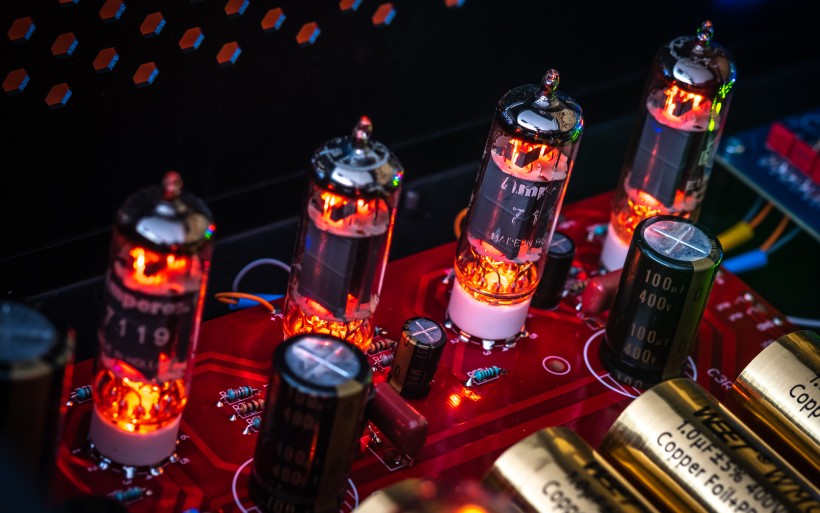 I keep away from reviewing audio hardware in a room that isn’t mine. Each such space simply has too many unknown variables to know which component does what exactly. It’s common sense really. This time around that wasn’t an issue. I was about to compare two devices in a very appealing system and just the way I like it. One test subject goes in, the other is out. Rinse and repeat. Besides, the main LampizatOr rig featured AudioNec’s second-best Evo 3 floorstanders and that’s always a treat to listen to. They connected to Pass Labs XA60.8 monos and those to a Genya DAC of choice that received data from the company’s SuperKomputer server/streamer. Roon attenuated signal in the digital domain, all electronics were powered from Kraftwerk-10 distributor and cables in use were a mixture of LampizatOr’s own products and upper-echelon KBL Sound designs.
I keep away from reviewing audio hardware in a room that isn’t mine. Each such space simply has too many unknown variables to know which component does what exactly. It’s common sense really. This time around that wasn’t an issue. I was about to compare two devices in a very appealing system and just the way I like it. One test subject goes in, the other is out. Rinse and repeat. Besides, the main LampizatOr rig featured AudioNec’s second-best Evo 3 floorstanders and that’s always a treat to listen to. They connected to Pass Labs XA60.8 monos and those to a Genya DAC of choice that received data from the company’s SuperKomputer server/streamer. Roon attenuated signal in the digital domain, all electronics were powered from Kraftwerk-10 distributor and cables in use were a mixture of LampizatOr’s own products and upper-echelon KBL Sound designs.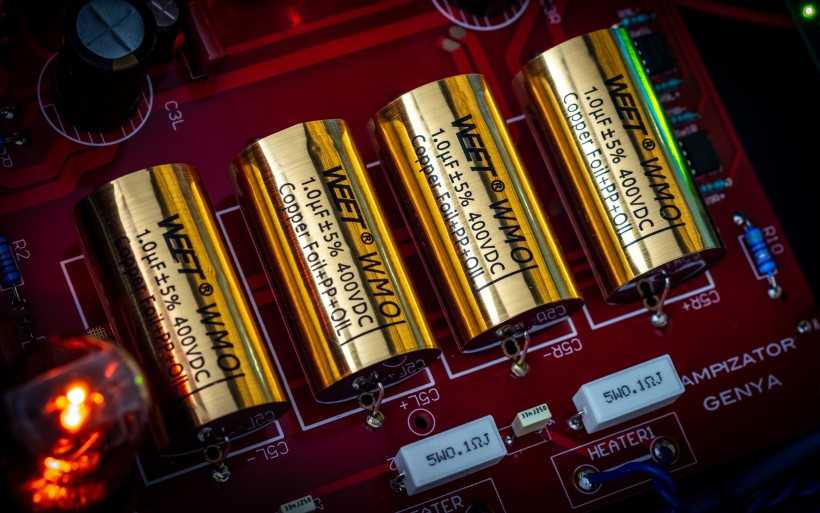 To compare the two Genya subjects at the Lampizator HQ, I simply had to mute playback, move one USB and two XLRs from one to the other, adjust volume by about 2dB (Genya Plus is a bit louder due to the tubes in it), press unmute, then hit play and that was it. Both DACs saw identical power cords, so there was no need to turn them on/off and that significantly sped up the necessary back and forths. On exterior alone, Genya Lite and Plus were pretty much identical. The word “Plus” on the latter’s forehead was the only cosmetic thing that set them apart. Also, their input selection LEDs had been incorporated into the front panels just a hair above their dual-function buttons. In my loaner these diodes located behind its acrylic window and didn’t look as nice, so I appreciated this minor rework. The key component differences between the two Genya DACs were found inside. The Plus version priced at €19’000 housed a gold-plated PCB busy with a quad of NOS Amperex 7119 tubes and WMO CiO (Copper-in-Oil) output capacitors made by the Chinese company WEE Technology. Łukasz deemed these bits as significantly better than their couterparts used in Genya Lite.
To compare the two Genya subjects at the Lampizator HQ, I simply had to mute playback, move one USB and two XLRs from one to the other, adjust volume by about 2dB (Genya Plus is a bit louder due to the tubes in it), press unmute, then hit play and that was it. Both DACs saw identical power cords, so there was no need to turn them on/off and that significantly sped up the necessary back and forths. On exterior alone, Genya Lite and Plus were pretty much identical. The word “Plus” on the latter’s forehead was the only cosmetic thing that set them apart. Also, their input selection LEDs had been incorporated into the front panels just a hair above their dual-function buttons. In my loaner these diodes located behind its acrylic window and didn’t look as nice, so I appreciated this minor rework. The key component differences between the two Genya DACs were found inside. The Plus version priced at €19’000 housed a gold-plated PCB busy with a quad of NOS Amperex 7119 tubes and WMO CiO (Copper-in-Oil) output capacitors made by the Chinese company WEE Technology. Łukasz deemed these bits as significantly better than their couterparts used in Genya Lite.
While it may seem that the tubes and caps as listed aren’t worth the extra €3’000, in practice these means fully sufficed to make a demostrable difference. The first and as it turned out firm observations came after mere two hardware rotations. I can’t say that I was surprised. When two fine DACs clash in a very resolving system, things either happen instantly, or they don’t at all. That said, each time the Genya Plus was engaged, wider dynamic span, additional heft, larger spatial frames, higher momentum and overall ease followed. While sonically accomplished on its own right, the Lite version felt spatially somewhat constricted, leaner, more innocent and a touch compressed and distant in comparison. That’s all she wrote, no commentary above that short feedback is necessary. Here I should say that the delta of changes upon moving from one Genya to the other wasn’t a night and day by any stretch. It was however sensible and repeatable, particularly on raunchy fare that clearly showed that the Plus version was simply more gifted where it mattered. All in all, forking out additional €3K on it feels justified considering the noticeable performance hike unlocked in return.
Associated Equipment:
- Amplifier: Trilogy 995R, FirstWatt F7, Enleum AMP-23R
- DAC: LampizatOr Horizon360 (Stradi 5U4G + Psvane Art TIII 4x KT88 / 2x 6SN7)
- Speakers: Boenicke Audio W11 SE+, sound|kaos Vox 3afw
- Transport: Innuos Statement, fidata HFAS1-S10U
- Preamplifier: Trilogy 915R, Thöress DFP
- Speaker cables: Boenicke Audio S3, LessLoss C-MARC
- Headphones: HifiMan Susvara
- Speaker signal conditioning: LessLoss Firewall for Loudspeakers, Boenicke ComDev
- Anti-vibration conditioning: 6x Carbide Base Diamond (under streamer), 6x Carbide Base Micro Diamond with TwinDamp inserts and spikes (under DAC and pre), Vibra 68 (under speakers)
- Interconnects: LessLoss Entropic Process C-MARC, Boenicke Audio IC3 CG
- Power components: Gigawatt PC-3 SE EVO+/LC-3 EVO, LessLoss C-MARC, LessLoss Entropic C-MARC, LessLoss Stellar C-MARC, LessLoss Power Distributor into Boenicke Audio Power Gate, ISOL-8 Prometheus
- USB components: AudioPhonique Desire USB
- Rack: Franc Audio Accesories Wood Block Rack 1+3
- Network: Fidelizer EtherStream, Linksys WRT160N
- Music: NativeDSD
Retail prices of reviewed components in EU (incl. VAT):
- LampizatOr Genya “Lite”: €16’000
- LampizatOr Genya “Plus”: €19’000
Manufacturer: LampizatOr


































